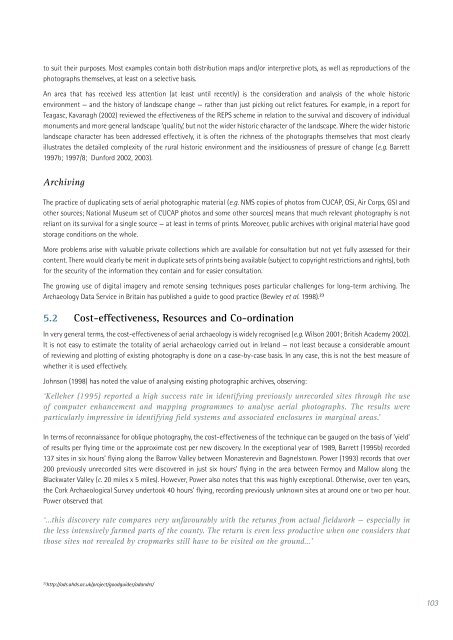Aerial Archaeology in Ireland - The Heritage Council
Aerial Archaeology in Ireland - The Heritage Council
Aerial Archaeology in Ireland - The Heritage Council
You also want an ePaper? Increase the reach of your titles
YUMPU automatically turns print PDFs into web optimized ePapers that Google loves.
to suit their purposes. Most examples conta<strong>in</strong> both distribution maps and/or <strong>in</strong>terpretive plots, as well as reproductions of the<br />
photographs themselves, at least on a selective basis.<br />
An area that has received less attention (at least until recently) is the consideration and analysis of the whole historic<br />
environment — and the history of landscape change — rather than just pick<strong>in</strong>g out relict features. For example, <strong>in</strong> a report for<br />
Teagasc, Kavanagh (2002) reviewed the effectiveness of the REPS scheme <strong>in</strong> relation to the survival and discovery of <strong>in</strong>dividual<br />
monuments and more general landscape ‘quality,’ but not the wider historic character of the landscape. Where the wider historic<br />
landscape character has been addressed effectively, it is often the richness of the photographs themselves that most clearly<br />
illustrates the detailed complexity of the rural historic environment and the <strong>in</strong>sidiousness of pressure of change (e.g. Barrett<br />
1997b; 1997/8; Dunford 2002, 2003).<br />
Archiv<strong>in</strong>g<br />
<strong>The</strong> practice of duplicat<strong>in</strong>g sets of aerial photographic material (e.g. NMS copies of photos from CUCAP, OSi, Air Corps, GSI and<br />
other sources; National Museum set of CUCAP photos and some other sources) means that much relevant photography is not<br />
reliant on its survival for a s<strong>in</strong>gle source — at least <strong>in</strong> terms of pr<strong>in</strong>ts. Moreover, public archives with orig<strong>in</strong>al material have good<br />
storage conditions on the whole.<br />
More problems arise with valuable private collections which are available for consultation but not yet fully assessed for their<br />
content. <strong>The</strong>re would clearly be merit <strong>in</strong> duplicate sets of pr<strong>in</strong>ts be<strong>in</strong>g available (subject to copyright restrictions and rights), both<br />
for the security of the <strong>in</strong>formation they conta<strong>in</strong> and for easier consultation.<br />
<strong>The</strong> grow<strong>in</strong>g use of digital imagery and remote sens<strong>in</strong>g techniques poses particular challenges for long-term archiv<strong>in</strong>g. <strong>The</strong><br />
<strong>Archaeology</strong> Data Service <strong>in</strong> Brita<strong>in</strong> has published a guide to good practice (Bewley et al. 1998). 23<br />
5.2 Cost-effectiveness, Resources and Co-ord<strong>in</strong>ation<br />
In very general terms, the cost-effectiveness of aerial archaeology is widely recognised (e.g. Wilson 2001; British Academy 2002).<br />
It is not easy to estimate the totality of aerial archaeology carried out <strong>in</strong> <strong>Ireland</strong> — not least because a considerable amount<br />
of review<strong>in</strong>g and plott<strong>in</strong>g of exist<strong>in</strong>g photography is done on a case-by-case basis. In any case, this is not the best measure of<br />
whether it is used effectively.<br />
Johnson (1998) has noted the value of analys<strong>in</strong>g exist<strong>in</strong>g photographic archives, observ<strong>in</strong>g:<br />
‘Kelleher (1995) reported a high success rate <strong>in</strong> identify<strong>in</strong>g previously unrecorded sites through the use<br />
of computer enhancement and mapp<strong>in</strong>g programmes to analyse aerial photographs. <strong>The</strong> results were<br />
particularly impressive <strong>in</strong> identify<strong>in</strong>g field systems and associated enclosures <strong>in</strong> marg<strong>in</strong>al areas.’<br />
In terms of reconnaissance for oblique photography, the cost-effectiveness of the technique can be gauged on the basis of ‘yield’<br />
of results per fly<strong>in</strong>g time or the approximate cost per new discovery. In the exceptional year of 1989, Barrett (1995b) recorded<br />
137 sites <strong>in</strong> six hours’ fly<strong>in</strong>g along the Barrow Valley between Monasterev<strong>in</strong> and Bagnelstown. Power (1993) records that over<br />
200 previously unrecorded sites were discovered <strong>in</strong> just six hours’ fly<strong>in</strong>g <strong>in</strong> the area between Fermoy and Mallow along the<br />
Blackwater Valley (c. 20 miles x 5 miles). However, Power also notes that this was highly exceptional. Otherwise, over ten years,<br />
the Cork Archaeological Survey undertook 40 hours’ fly<strong>in</strong>g, record<strong>in</strong>g previously unknown sites at around one or two per hour.<br />
Power observed that<br />
‘…this discovery rate compares very unfavourably with the returns from actual fieldwork — especially <strong>in</strong><br />
the less <strong>in</strong>tensively farmed parts of the county. <strong>The</strong> return is even less productive when one considers that<br />
those sites not revealed by cropmarks still have to be visited on the ground…’<br />
23 http://ads.ahds.ac.uk/project/goodguides/adandrs/<br />
103

















